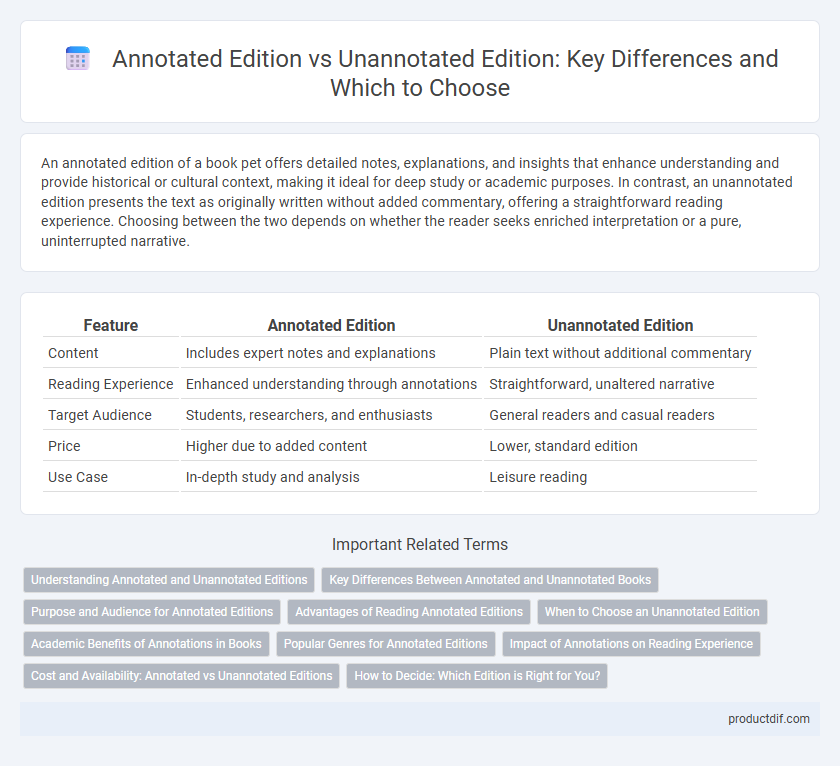An annotated edition of a book pet offers detailed notes, explanations, and insights that enhance understanding and provide historical or cultural context, making it ideal for deep study or academic purposes. In contrast, an unannotated edition presents the text as originally written without added commentary, offering a straightforward reading experience. Choosing between the two depends on whether the reader seeks enriched interpretation or a pure, uninterrupted narrative.
Table of Comparison
| Feature | Annotated Edition | Unannotated Edition |
|---|---|---|
| Content | Includes expert notes and explanations | Plain text without additional commentary |
| Reading Experience | Enhanced understanding through annotations | Straightforward, unaltered narrative |
| Target Audience | Students, researchers, and enthusiasts | General readers and casual readers |
| Price | Higher due to added content | Lower, standard edition |
| Use Case | In-depth study and analysis | Leisure reading |
Understanding Annotated and Unannotated Editions
Annotated editions enhance comprehension by providing explanatory notes, historical context, and critical analysis alongside the main text, helping readers grasp complex themes and references. Unannotated editions offer the original text without supplementary commentary, appealing to readers who prefer an uninterrupted, authentic reading experience. Choosing between the two depends on the reader's preference for guidance or independence in interpreting the literary work.
Key Differences Between Annotated and Unannotated Books
Annotated editions provide in-depth commentary, explanations, and contextual notes that enhance understanding of the text, making them ideal for academic study or detailed analysis. Unannotated editions present the original content without additional explanations, preserving the author's intended reading experience and allowing readers to interpret the material independently. Key differences include the presence of scholarly notes, cross-references, and historical context in annotated books versus the straightforward, unaltered text found in unannotated editions.
Purpose and Audience for Annotated Editions
Annotated editions serve readers seeking deeper comprehension, offering extensive notes, explanations, and contextual information that illuminate the text's nuances. They are tailored for scholars, students, and enthusiasts interested in critical analysis, historical background, or thematic exploration. This format enhances educational value and supports academic research by providing interpretive commentary alongside the original content.
Advantages of Reading Annotated Editions
Annotated editions of books provide enriched context through detailed notes, explanations, and background information that deepen comprehension and enhance appreciation of the text. Readers benefit from historical, cultural, and linguistic insights that clarify complex passages and uncover hidden meanings often missed in unannotated editions. This supplementary material supports critical engagement and scholarly research, making annotated editions valuable resources for students and enthusiasts seeking a more informed reading experience.
When to Choose an Unannotated Edition
Choose an unannotated edition when seeking a pure, uninterrupted reading experience that preserves the author's original voice and intent without external commentary. This version is ideal for readers who prefer to interpret the text independently or use it as a primary source in academic research. Unannotated editions are often favored by literary purists, students with a strong foundational knowledge, and those who wish to avoid potential bias from external notes.
Academic Benefits of Annotations in Books
Annotated editions provide in-depth explanations, historical context, and critical analysis that enhance comprehension and deepen engagement with the text. Academic readers benefit from annotations as they clarify complex concepts, reveal subtext, and connect themes to broader scholarly discussions. These insights foster critical thinking and support more rigorous research compared to unannotated editions.
Popular Genres for Annotated Editions
Annotated editions are particularly popular in classic literature, historical fiction, and academic texts, where detailed notes provide critical insights, context, and interpretations that enhance the reader's understanding. These genres benefit from annotations that explain obscure references, historical background, and linguistic nuances, making the reading experience richer and more educational. Unannotated editions appeal to readers seeking a straightforward narrative without interruptions or scholarly commentary.
Impact of Annotations on Reading Experience
Annotated editions enrich the reading experience by providing context, explanations, and interpretations that deepen understanding and engagement with the text. Unannotated editions offer a more personal and uninterrupted narrative flow, allowing readers to interpret the material independently. The presence of annotations can significantly enhance comprehension, especially for complex or historical works, but may also influence reader immersion by interjecting commentary throughout the text.
Cost and Availability: Annotated vs Unannotated Editions
Annotated editions typically carry a higher price due to their detailed notes, expert commentary, and supplementary materials that enhance reader understanding. Unannotated editions are more widely available and affordable, appealing to casual readers or those seeking the core text without additional analysis. The cost disparity reflects the value added by annotations, affecting accessibility based on budget and reading preferences.
How to Decide: Which Edition is Right for You?
Selecting between an annotated edition and an unannotated edition depends on your reading goals and level of familiarity with the text. Annotated editions provide detailed notes, explanations, and context that enhance understanding, making them ideal for students, researchers, or readers seeking deeper insight. Unannotated editions offer a straightforward reading experience, perfect for those who prefer to interpret the work independently or focus solely on the narrative.
Annotated Edition vs Unannotated Edition Infographic

 productdif.com
productdif.com